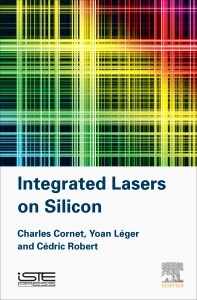Description
Integrated Lasers on Silicon
Authors: Cornet Charles, Léger Yoan, Robert Cédric
Language: English
Subject for Integrated Lasers on Silicon:
80.59 €
In Print (Delivery period: 14 days).
Add to cartSupport: Print on demand
Description
/li>Contents
/li>Readership
/li>Biography
/li>Comment
/li>
Integrated Lasers on Silicon provides a comprehensive overview of the state-of-the-art use of lasers on silicon for photonic integration. The authors demonstrate the need for efficient laser sources on silicon, motivated by the development of on-board/on-chip optical interconnects and the different integration schemes available. The authors include detailed descriptions of Group IV-based lasers, followed by a presentation of the results obtained through the bonding approach (hybrid III-V lasers). The monolithic integration of III-V semiconductor lasers are explored, concluding with a discussion of the different kinds of cavity geometries benchmarked with respect to their potential integration on silicon in an industrial environment.
1: Laser Integration Challenges
2: Group IV Silicon Lasers
3: III–V Lasers Bonded on Si
4: Monolithic III–V Lasers on Silicon
5: Laser Architectures for On-chip Information Technologies
Yoan Léger received the PhD degree in Physics from Université Joseph Fourier, Grenoble, France, in 2007 for his investigation of the optoelectronic properties of individual II-VI magnetic quantum dots and the demonstration of the optical detection of a single magnetic atom spin in the solid state. He then joined B. Deveaud’s group in EPFL (Switzerland) and focused his work on the nonlinear properties of semiconductor microcavities in the strong coupling regime, from polariton multistability and all-optical spin switching to superfluidity. Since 2012, hehas worked as a CNRS researcher in Foton laboratory on the monolithic integration of nonlinear and active photonic micro-resonators on silicon.
Dr. Léger is the co-author of 60 publications, counting more than 1100 citations. He is a reviewer for Nature publishing group, the Optical Society and the American Physical Society.
Cédric Robert obtained a PhD in physics and optoelectronics at INSA Rennes (France) where he studied nanostructures on GaP for the monolithic integration of a laser structure on silicon. He then moved to the III-V materials and devices group of the Tyndall National Institute (Ireland) where he designed, fabricated and characterized
- Features a clear description of the advantages, drawbacks, and challenges of laser integration on silicon
- Serves as a staple reference in the general field of silicon photonics
- Focuses on the promising developments of hybrid and monolithic III-V lasers on silicon, previously unreviewed
- Discusses the different kinds of cavity geometries benchmarked with respect to their potential integration on silicon in an industrial environment
These books may interest you

Silicon Photonics 193.44 €



